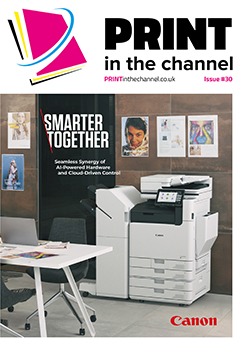Supporting sustainability and the circular economy is becoming increasingly important for businesses, and one way that can be done is through purchasing remanufactured printers rather than new ones.
In August, the cycling world descended on Glasgow for the UCI Cycling World Championships. This is the world’s largest cycle event, spanning 11 cycle disciplines in multiple locations, with 284 different teams and country delegations from around the world.
While spectators from around the world marvelled at the top class cycling on display, printing and printers were probably the last thing on their mind.
Printing is one of those things that goes unheralded at such an event, but it is fundamental to the smooth running of it – whether it is printing out passes for press and dignitaries, documents for competitors to fill out or even just running orders for the day or any one of hundreds of other items, the event would quickly grind to a halt without it.
For the event, Union Cycliste Internationale (UCI), the world governing body of cycling, along with Glasgow Life and CGI, selected Xerox to provide devices certified to meet internationally recognised security and product sustainability standards.
Xerox supported the UCI’s essential print and copying services across the full cycle championships, including supplying a team of onsite engineering support staff and service delivery team from Glasgow and the surrounding areas.
With the UCI, like many sporting bodies, now trying to reduce its carbon footprint at large-scale events, Xerox helped towards this aim by ensuring that all printers supplied were remanufactured.
The devices were remanufactured near Glasgow at Concept, a Xerox Business Solutions company, in Clydebank, which was recently awarded the BSI kitemark BS 8887-220:2010. The devices have earned Electronic Product Environmental Assessment Tool (EPEAT), Blue Angel and ENERGY STAR ecolabels.
To realise the ambition of providing print technology with sustainability benefits to the championships, Xerox used onsite engineering staff to proactively visit each device daily to enable optimum uptime through the event. Devices were configured to reduce power consumption through energy saving settings including reduced toner consumption in draft print mode to help lower the carbon footprint. Users also had multiple ways of printing and scanning, including Xerox’s PrintByXerox cloud-based app, Scan to Cloud Email app, Scan to USB, Print from USB and USB cable printing. In addition, Xerox provided FSC-certified paper with 100% post-consumer recycled content.
“Xerox has a proven legacy in supporting similar scale events throughout the UK, including the London Olympics in 2012, European Championships in Glasgow in 2018, Glasgow 2019 European Short Course Swimming Championships and most recently the COP26 Climate Action Conference also in Glasgow in 2021, so we [were] delighted to be providing print services for the UCI Cycling World Championships,” says Darren Cassidy, managing director, Xerox UK&I.
“The UCI’s Sustainability Vision to make cycling one of the world’s most sustainable sports and promote the bicycle as a key transport mode in combating climate change, improving population health and building a more sustainable future for all is fully aligned with our core values. Our appointment is a testament to our commitment to fighting climate change, and our journey to net zero by 2040 whilst helping to make a positive difference on one of the world’s most pressing issues.”
After the event, Xerox remanufactured all the printers at its Concept plant to extend their life again and continue to promote a circular economy.
This shows what can be done in large scale events to help reduce carbon footprint and extend the life of printers – but businesses of all sizes and in all sectors could take advantage of remanufactured printers if they had the opportunity.
What is remanufacturing?
Remanufacturing is a process that involves rebuilding a printer that has reached the end of its life – perhaps having been used for several years on a print-as-a-service contract. The printer is disassembled, every part is given a thorough clean and assessed before worn out or obsolete parts are replaced using a mix of parts from other printers or that have been repaired themselves or new parts.
In addition, when Canon remanufactures printers, it ensures that hard drives are erased and reformatted and the machine is upgraded with the latest firmware. The counters are set to zero, and the machine is assigned a fresh serial number. Other companies do similar.
The aim of remanufacturing is to end up with a printer that is like new or, in some cases, better than new, if it has been upgraded with newer parts than it had originally, which is as reliable as the original was – and can last as long again as it did in its original workplace scenario.
In theory, if a printer is designed to be remanufactured, it can be remanufactured any number of times. Printers – be they laser, inkjet or multifunction – are ideal for being remanufactured due to the value of them and availability of components.
Remanufacturing is often undertaken by manufacturers, contracted companies working on behalf of manufacturers and independent businesses.
Remanufacturing printers helps reduce waste and conserve resources. By extending the lifecycle of printers, remanufacturing reduces the need for new manufacturing and minimises the environmental impact associated with the production of new devices.
Remanufacturing vs refurbishing
But it should be noted that remanufacturing is distinct to refurbishing. Claire Hobby, director purchaser engagement, global at TCO Development, notes that remanufacturing and refurbishing both lengthen the lifetime of products, which is critical for reducing carbon footprints.
“What distinguishes remanufacturing from refurbishment is that remanufacturing involves disassembly, thorough cleaning, inspection, worn part replacement and rigorous testing, ensuring it meets original standards,” she says. “Whereas refurbishing primarily addresses external components and basic functionality issues without comprehensive overhaul or component replacement.”
As a result, remanufacturing is more costly than refurbishing, but the result is a higher standard of product.
Benefits of remanufacturing
There are numerous benefits of remanufacturing printers. Firstly, remanufactured printers provide a high level of performance. When a printer is remanufactured, it is upgraded to current standards of performance and efficiency, so customers should notice no different between that and a new printer.
However, for customers, there is the advantage that remanufactured printers are cheaper than brand new products. This is because savings are made on the parts within it.
Likewise, it is more environmentally friendly as it uses fewer raw materials than a new one, and, as a result, requires less energy to create, thus cutting its carbon footprint. It also means that there is less going into landfill. Some of the components used in printers cannot be recycled and therefore usually end up in landfill at the end of a printer’s life – remanufacturing can keep some of these in the production cycle instead.
Remanufactured products come with warranties – the same as for new printers – for added peace of mind.
Runner way
Remanufacturing is still relatively small-scale in the UK, but it is gaining traction in other parts of the world. For instance, in April, Canon Europe launched the imageRUNNER ADVANCE ES Range – the latest addition to its established portfolio of remanufactured devices. Comprising colour and black and white options, the range uses at least 90% used parts, while offering businesses the high-quality functionality of Canon’s popular imageRUNNER ADVANCE Generation 3 printers.
The ES Range comprises three products – the imageRUNNER ADVANCE C5560i ES, C5560i ES+ and the black and white imageRUNNER 4545i ES, which are remanufactured at Canon’s dedicated factory in Giessen, Germany. Canon’s imageRUNNER ADVANCE Generation 3 printers are deconstructed, rigorously cleaned, tested and then rebuilt. Once strict quality standards have been met, the machines are then resold to customers at a lower price point than brand-new equivalent machines.
“We recognise the critical responsibility we have to limit our environmental impact and offer our customers a range of options including remanufactured, refurbished and new devices,” said Marc Bory, vice president of digital printing and solutions marketing and Innovation at Canon Europe. “One way we are addressing this is by contributing towards the circular economy by keeping parts and materials in use for longer.
“With built in functionality to help businesses drive productivity and deliver workflow efficiencies, customers can benefit from a superior device which comes with a full warranty, just like our new products.”
This range is available across Europe, but not in the UK.
Growing interest
With sustainability increasingly important for many businesses in all industries, interest is growing in remanufacturing across the IT landscape and the printing industry is no exception, according to Claire. “In fact, we’ve seen an increase in remanufactured and refurbished printers, which has been driven by a collective commitment across businesses to sustainability,” she says.
“For instance, at TCO Development, we’ve observed a growing interest in remanufactured and refurbished IT products including printers, which helps support the environment but also offers consumers value for money options.
“What is especially encouraging is that businesses are becoming more aware of the need to reduce waste and carbon emissions across the value-chain, otherwise known as scope 3 emission reduction. This is because scope 3 emissions pose the greatest challenge for larger organisations, making remanufacturing one important practice to support carbon reduction throughout operations.
“To put the matter of carbon reduction into context, the technology industry currently contributes 4% of global emissions, with artificial intelligence’s increasing prominence expected to amplify this figure. As a result, the industry plays a pivotal role in the UK’s journey to Net Zero emissions by 2050. Furthermore, the Circularity Gap Report reveals that over 90% of the UK’s materials originate from virgin sources, 80% of which are imported, and only 7.5% re-enters the UK economy. Transitioning to a circular economy, of which remanufacturing plays a key role, especially in technology, can annually reduce global greenhouse gas emissions by up to 9.3 billion of CO2 by 2050, aligning with the UK’s ambitious goals.”
Claire adds that remanufacturing is one of several important components of the circular economy. “At TCO Development, we encourage a range of solutions including increasing the product lifecycle and sourcing more sustainable products,” she says. “Moreover, as legislation for businesses to disclose carbon footprints increases, cooperation and collaboration with partners will become more important as businesses will be required to engage with suppliers to track supply chain or scope 3 emissions, throughout the value chain.”
How resellers can get involved
With sustainability issues set to continue to grow in importance in the coming years, this could be a profitable line for resellers in the future – and one to be looking into adding to their product mix now. While it may not be right for every customer, for those looking to replace large printer fleets, it could be a cost-effective option.
“Resellers interested in remanufacturing often collaborate with manufacturers or specialised remanufacturing firms, accessing expertise, technology and resources,” says Claire. “Getting involved in remanufacturing incentives and recycling programmes are examples of ways to reduce unnecessary waste, cost and carbon emissions.”
It is something that should be included in conversations with customers about sustainability, especially as knowledge of remanufacturing and what it is – and the quality of remanufactured printers – is relatively low currently. Explaining what it is and the benefits of it could help to change minds.










